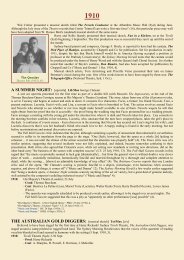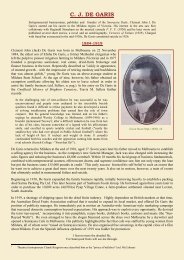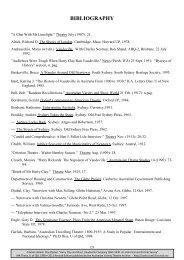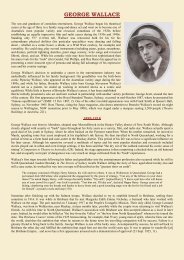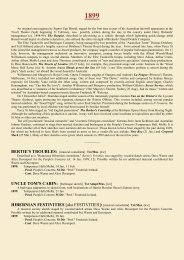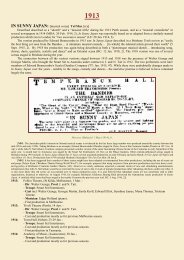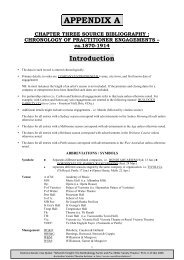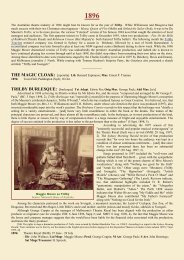ALFRED DAMPIER - Australian Variety Theatre Archive
ALFRED DAMPIER - Australian Variety Theatre Archive
ALFRED DAMPIER - Australian Variety Theatre Archive
You also want an ePaper? Increase the reach of your titles
YUMPU automatically turns print PDFs into web optimized ePapers that Google loves.
<strong>ALFRED</strong> <strong>DAMPIER</strong><br />
One of the most significant <strong>Australian</strong>-based actor/managers of the 19th century, Alfred Dampier<br />
came to the Antipodes in 1873 under contract to H. R. Harwood and George Coppin. He operated his<br />
own company around the region for several years before touring the USA and UK ca. 1878. After<br />
returning to Australia he had much success with melodrama. His music theatre works included<br />
Helen’s Babies and Uncle Tom’s Cabin. The sensation melodrama Marvellous Melbourne (1889) also<br />
contained much music.<br />
Alfred Dampier was likely born at Horsham (Sussex, Eng) on 28<br />
February 1847. [see "Historical Notes" below] He began his working<br />
career in a barrister's office, having completed his education at<br />
Charterhouse School, England. After dabbling with local amateur<br />
productions he eventually decided against a legal career and turned<br />
instead to the professional stage. One of his earliest known engagements<br />
was with a Manchester-based theatre company headed by Henry Irving.<br />
After Irving left for London in 1866 Dampier became its leading actor. A<br />
short while later, however, he also made the move to the English capital<br />
and set about developing his craft there. He eventually graduated to lead<br />
actor status and was subsequently invited to visit Australia in 1873 by<br />
Henry R. Harwood and George Coppin. He made his <strong>Australian</strong> debut<br />
later that year in his own adaptation of Faust and Marguerite (<strong>Theatre</strong><br />
Royal, Melbourne) and soon afterwards formed a company made up of<br />
mostly local actors. The decision by Dampier to concentrate his efforts in<br />
Australia would, over the next three decades, see his organisation become<br />
not only one of the leading theatrical troupes operating in the antipodes,<br />
but also make his name a household one.<br />
Source: State Library of Tasmania<br />
Source: State Library of Victoria.<br />
Dampier's reputation as a Shakespearian actor gave him the opportunity to<br />
mount numerous productions of the bard's works throughout the colonies<br />
over the next few years (although none fared as well as his later melodramas -<br />
the theatrical enterprises that in fact became his trademark). The success he<br />
garnered in Australia and New Zealand during the mid-1870s saw him<br />
attempt to reproduce similar results in America in 1878, but the tour did not<br />
ignite much interest. He returned to Australia for a period, before trying his<br />
luck on several tours through the United Kingdom. After failing to establish<br />
himself in Britain he eventually returned to Australia, where between 1880<br />
and 1885 he alternated Sydney and Melbourne with occasional regional tours.<br />
During this time he also began to develop his own writing craft. His most<br />
significant collaborations were with playwrights like F. R. C. Hopkins and<br />
journalist John Stanley James (aka Julian Thomas/ "Vagabond"). Another<br />
of his successes from this period of his career, too, was The Flying Dutchman<br />
(aka the Phantom Ship) written by his wife Katherine (nee Russell). It was<br />
first staged in 1880.<br />
For some three years beginning in 1885, Dampier settled in to an almost<br />
continuous season in Sydney, first at the Gaiety <strong>Theatre</strong> and later at the Royal<br />
Standard <strong>Theatre</strong> in Castlereagh Street. Some of his earlier debut productions<br />
included his own drama Under the Southern Cross (1885); a collaborative<br />
adaptation with John F. Sheridan of Uncle Tom's Cabin (1886); F. R. C.<br />
Hopkins' All for Gold (1886); and another original work, Our Emily (1886).<br />
This period in Sydney also saw Dampier strive more and more to promote<br />
<strong>Australian</strong> drama and <strong>Australian</strong> stories – not just his own works but also<br />
those by other local playwrights. His strategy paid off almost immediately<br />
when he scored a significant hit with For the Term of His Natural Life (1886)<br />
which he co-adapted with Thomas Somers from Marcus Clarke's novel.<br />
Dampier also organised a play competition as part of country's centennial<br />
celebrations, staging the winning entry, John Perry's The Life and Death of<br />
Captain Cook, on 28 January 1888.
At the end of 1888 Dampier moved his operations to the Alexandra <strong>Theatre</strong>, Melbourne. It was there, and in<br />
collaboration with Garnet Walch, that he wrote a string of original melodramas that effectively placed him among the<br />
most important and influential dramatist/actor/managers in <strong>Australian</strong> theatre history. These works included<br />
Marvellous Melbourne, which they co-wrote with J. H. Wrangham and Thomas Somers in 1889. The first of the<br />
Dampier/Walch melodramas, however, was The Count of Monte Cristo (1890). This was followed shortly afterwards<br />
by a hugely popular adaptation of Rolfe Boldrewood's Robbery under Arms (1890), then For Love and Life (q.v.,<br />
1890), The Miner's Right (1891), The Scout (1891), The Trapper (1891), This Great City (1891), Wilful Murder<br />
(1892) and Help One Another (1892). Dampier also produced Walch's Jack the Giant Killer in 1891.<br />
As with many of his theatrical contemporaries the depression had a drastic impact on Dampier's financial resources.<br />
He was eventually forced to close his Melbourne season in 1892 and attempted to address the situation by mounting a<br />
tour of New Zealand. This proved a disaster, however, and he subsequently entered into a brief period of insolvency.<br />
His initial reaction to this situation was to return to England, but he fared no better than the last time. Even his<br />
production of Robbery under Arms at the Princess <strong>Theatre</strong> failed to attract much positive attention from the London<br />
critics, although his acting was given much praise.<br />
By now resigned to the fact that Australia still held the most promise for<br />
him, Dampier returned in 1894 and set about trying to re-establish his<br />
somewhat tarnished reputation. The task was by no means easy.<br />
Victoria remained a difficult place for him to tour for several years (due<br />
primarily to the fact that he had been declared bankrupt in that state), and<br />
while the rest of the country was supportive, the theatre industry continued<br />
to struggle throughout the remainder of the decade in an economic<br />
environment shattered by the depression. Added to these problems was a<br />
scandal concerning Lily Dampier's private life, and frequent health<br />
problems that he (and his wife) endured throughout their later years. Despite<br />
these problems Dampier managed to claw his way back to the position he<br />
had commanded at the peak of his career in the late 1880s, a factor<br />
that undoubtedly endeared him to both the critics and public alike during the<br />
remainder of his professional life. Indeed, Richard Fotheringham notes that<br />
during this period Dampier came to be regarded as a courtly gentleman and<br />
scholarly actor, who although not challenging the operations of the more<br />
prosperous operations of J. C. Williamson, William Anderson and Bland<br />
Holt was nevertheless a sentimental favourite of the <strong>Australian</strong> stage at that<br />
time (180).<br />
Alfred Dampier died in Sydney on 23 May 1908 of a brain haemorrhage.<br />
He left behind his wife, Katherine, who as an actress had played a<br />
significant role in his career, his two daughters and a son, the actor Alfred<br />
Dampier Jnr (aka Fred). Lily Dampier and her husband Alfred Rolfe<br />
Alfred and Lily Dampier<br />
Source: National Library of Australia<br />
adapted several of Dampier's scripts for early <strong>Australian</strong> films. He also left behind a significant legacy of<br />
achievement. His role in helping develop both an <strong>Australian</strong> theatrical tradition and the industry itself certainly cannot<br />
be questioned. Later prominent actor/writers like Bert Baily and Edmund Duggan are known to have acknowledged<br />
his influence on their early careers. In addition, many leading actors of the era found employment with him for<br />
extended periods of time, and in turn passed on their experiences to other actors - whether as peers or as pedagogues.<br />
Such actors include Harry Leston, Harry W. Emmet, Lachlan McGowan, Carrie Bilton, Harry Sefton, J. R. Greville,<br />
Harry Stoneham and J. B. Atholwood (father of actress Sybil Atholwood).<br />
1877: Helen's Babies [play with music]<br />
1879: Uncle Tom's Cabin [play with music]<br />
1886: Uncle Tom's Cabin [ play with music]<br />
MUSIC THEATRE WORKS
HISTORICAL NOTES<br />
1. Dampier's birth year differs in various sources. These dates range from 1843 to 1848.<br />
2. His adaptation of Richard III was printed in 1879 by Azzopardi, Hildreth and Co (Melb).<br />
3. Dampier adapted at least two works for the stage under the pseudonym Adam Pierre. These were Briton and Boer<br />
(1899), an adaptation of H. Rider Haggard's Jess; and The Bush King (1901), which he reworked in collaboration<br />
with the original play's author W. J. Lincoln. The latter play was staged regularly by Dampier between 1901 and<br />
1908.<br />
4. Of the music directors and composers who worked with Dampier during his <strong>Australian</strong> career, the most<br />
frequently engaged was Percy H. Kehoe [aka Herbert Percy]. Dampier also worked with David Cope on a<br />
number of productions. Both of Dampier's adaptations of Harriet Beecher Stowe's Uncle Tom's Cabin (1879<br />
and 1886) contained songs and dance, with the latter production having a high musical content according to<br />
reviews. A number of other productions presented by Dampier also utilised music as part of the narrative,<br />
notably those which were presented in order to highlight the talents of his two daughters, Rose and Lily. One<br />
original work, for example, is Garnet Walch's adaptation of Helen's Babies (from the novelette by J.<br />
Habberton) which Dampier first staged in 1877. A significant amount of music, written by Kehoe, was also<br />
presented in Marvellous Melbourne.<br />
5. Other works written and/or adapted by Dampier during his career include: The Wreck of the Dunbar (1887),<br />
Shamus O'Brien (adapt. with Percy H. Kehoe, 1887) and An English Lass (written with C. H. Krieger, 1887). His<br />
version of Les Miserables, which he first staged in Sydney in 1877 (Victoria <strong>Theatre</strong>) was also produced in<br />
London four years later. Another successful and often revived production was his co-adaptation (with Julian<br />
Thomas) of Michael Strogoff; Or, Russia As It Is (1880), based on the Russian drama The Nihilists; Or Russia<br />
As It Is. Dampier's melodramas were invariably the success highlights of any season. Along with the spectacle<br />
he provided, these productions often included some degree of musical accompaniment, although this was more<br />
often than not of an incidental nature.<br />
6. Lily Dampier and her husband Alfred Rolfe adapted several of Dampier's scripts for early <strong>Australian</strong> films,<br />
including The Bush King, which was renamed Captain Midnight, the Bush King (1911)<br />
Above: Lily Dampier. <strong>Australian</strong> Town and Country Journal 27<br />
Nov. (1886), 28.<br />
Left: Source: National Library of Australia
Alfred and Lily Dampier<br />
Australasian Stage Annual (1905), 19.<br />
FURTHER REFERENCE<br />
"Alfred Dampier." Manuscript Collection, State Library of New South Wales.<br />
Campbell, N. "Alfred Dampier," SQ: 3. 1 (Jan. 1924), 28-30.<br />
"Dampiers, The." ARG: 16 Nov. (1878), 12 [press notices for US tour]<br />
"Death of Alfred Dampier." Obituary. SMH: 25 May (1908), 6.<br />
Djubal, Clay. "Dampier, Alfred." AustLit (2006).<br />
Fotheringham, Richard. CTTA: (1995), 180.<br />
Irvin, Eric. <strong>Australian</strong> Melodrama: Eighty Years of Popular <strong>Theatre</strong>. (1981), 60-77.<br />
McGuire, P. et al. The <strong>Australian</strong> <strong>Theatre</strong> (1948).<br />
Porter, Hal. Stars of the <strong>Australian</strong> Stage and Screen. (1965), v. pags.<br />
"Queries Answered: Topics of the Day - Drama (East Davenport)". ABT: 15 Jan. (1931), 6.<br />
Rees, Leslie. Towards an <strong>Australian</strong> Drama. (1953), 16-17, 22-8.<br />
Rickard, John. "Dampier, Alfred" ADB: 4 (1972), 13.<br />
--- "Alfred Dampier: An Actor-Manager in the Land of Romance." K: 3.14 (1973): 44-57.<br />
Williams, Margaret. Australia on the Popular Stage. (1983), 133-8.<br />
DT: 7 June (1906), n. pag.<br />
See also:<br />
Last updated: 17/03/2013<br />
Expanded and updated from Clay Djubal, "What Oh Tonight." Ph D Diss. U of Qld (2005), Appendix D.<br />
NB: The URL for this PDF will change each time it is updated. If you wish to cite or link to this record please use the following:<br />
<strong>Australian</strong> <strong>Variety</strong> <strong>Theatre</strong> <strong>Archive</strong> • http://ozvta.com/ozvta.com/practitioners-other-a-l/




